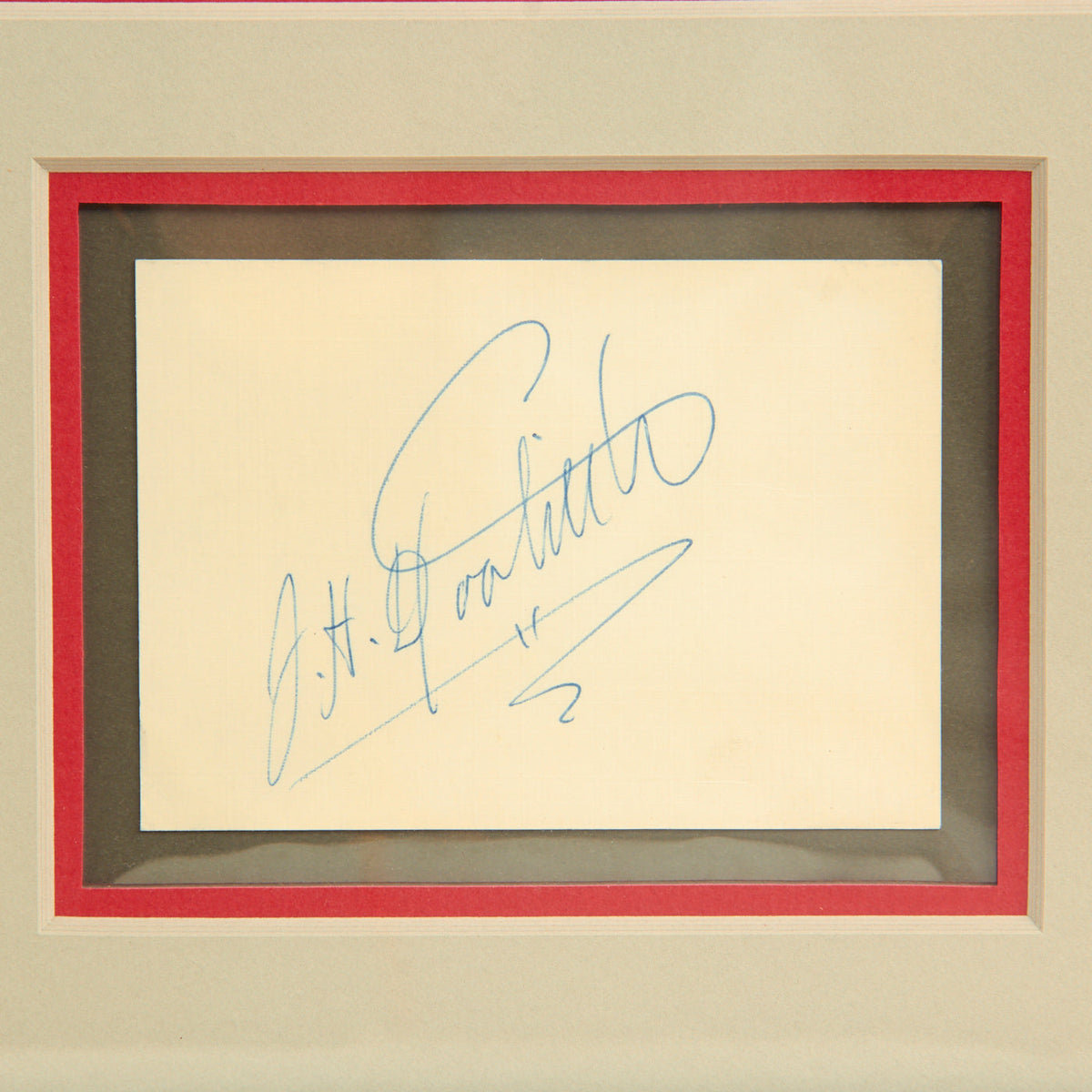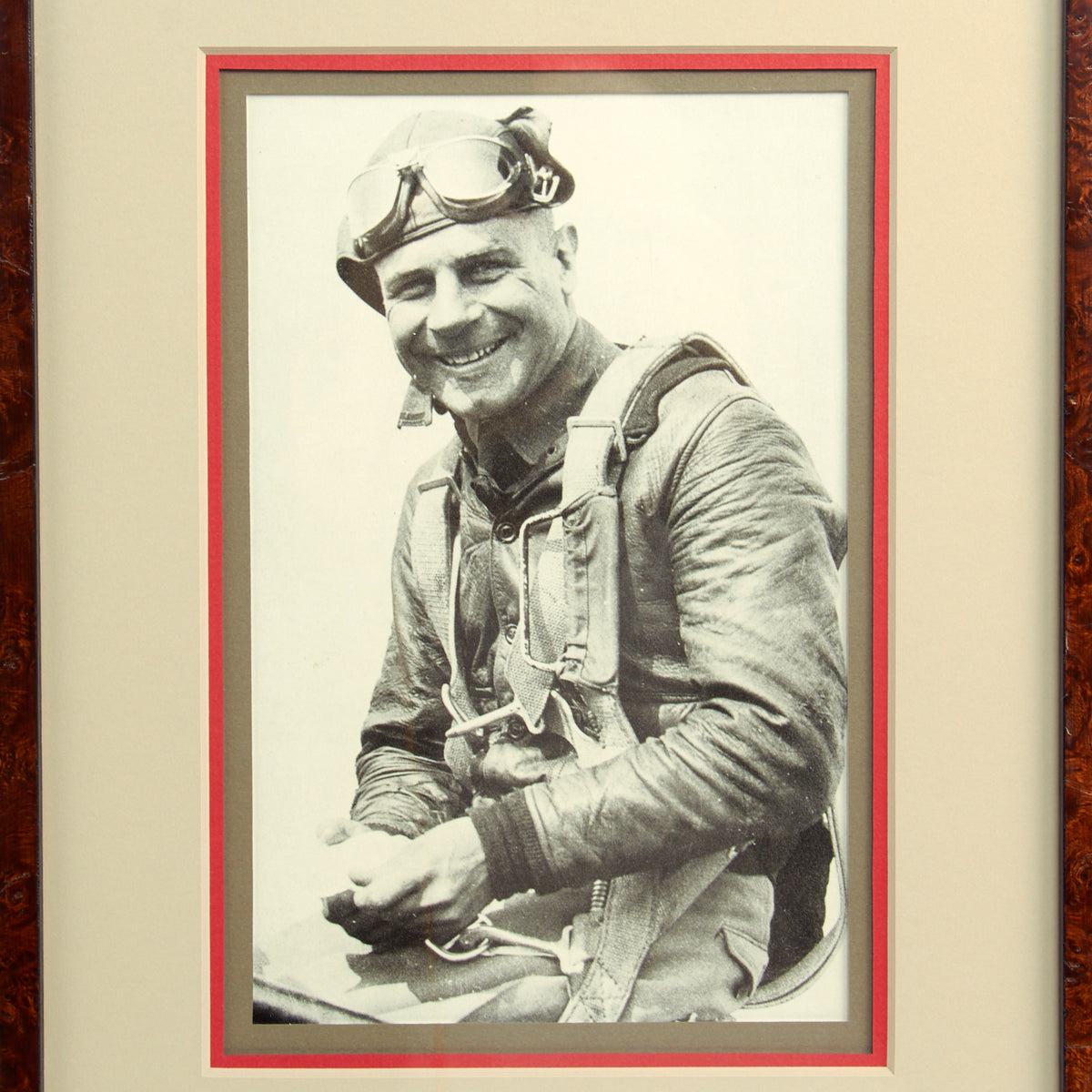Original Autograph: General James Harold Doolittle Framed Portrait and Signature – 17 ¾” x 11 ¼” UV Light Protected Frame Original Items
$ 495,00 $ 148,50
Original Item: Only One Available. James Harold Doolittle was an American military general and aviation pioneer who received the Medal of Honor for his daring raid on Japan during World War II. He also made early coast-to-coast flights, record-breaking speed flights, won many flying races, and helped develop and flight-test instrument flying.
This is a lovely framed combination of a Pre War photo of General Doolittle exiting his aircraft and in the smaller section is his personal signature on a piece of cardstock. The picture is a reprint but the signature is an authentic original. The frame is in excellent condition as are the contents. The signature is still very clear with the blue ink only faded slightly.
One of the best ways to protect your autograph is by framing it. Placing your autograph in a UV protective frame blocks the signature from ultraviolet rays that cause fading. Also, framing your signature makes it nearly impossible for damage to occur from any spills, smudges, or folding. The contents were framed using conservation glass featuring TruGuard, UV light blocking protection.
This is a beautiful framed example and would be extremely difficult to upgrade from. Comes more than ready for display!
Doolittle Raid
Following the reorganization of the Army Air Corps into the USAAF in June 1941, Doolittle was promoted to lieutenant colonel on January 2, 1942, and assigned to Army Air Forces Headquarters to plan the first retaliatory air raid on the Japanese homeland following the attack on Pearl Harbor. He volunteered for and received General H.H. Arnold’s approval to lead the top secret attack of 16 B-25 medium bombers from the aircraft carrier USS Hornet, with targets in Tokyo, Kobe, Yokohama, Osaka and Nagoya.
After training at Eglin Field and Wagner Field in northwest Florida, Doolittle, his aircraft, and volunteer flight crews proceeded to McClellan Field, California for aircraft modifications at the Sacramento Air Depot, followed by a short final flight to Naval Air Station Alameda, California for embarkation aboard the aircraft carrier USS Hornet. On April 18, Doolittle and his 16 B-25 crews took off from the Hornet, reached Japan, and bombed their targets. Fifteen of the planes then headed for their recovery airfield in China, while one crew chose to land in Russia due to their bomber’s unusually high fuel consumption. As did most of the other crewmen who participated in the one-way mission, Doolittle and his crew bailed out safely over China when their B-25 ran out of fuel. By then, they had been flying for about 12 hours, it was nighttime, the weather was stormy, and Doolittle was unable to locate their landing field. Doolittle came down in a rice paddy (saving a previously injured ankle from breaking) near Chuchow (Quzhou). He and his crew linked up after the bailout and were helped through Japanese lines by Chinese guerrillas and American missionary John Birch. Other aircrews were not so fortunate, although most eventually reached safety with the help of friendly Chinese. Seven crew members lost their lives, four as a result of being captured and murdered by the Japanese and three due to an aircraft crash or while parachuting. Doolittle thought he would be court martialed due to having to launch the raid ahead of schedule after being spotted by a Japanese patrol boat and the loss of all the aircraft.
Doolittle went on to fly more combat missions as commander of the 12th Air Force in North Africa, for which he was awarded four Air Medals. He later commanded the 12th, 15th and 8th Air Forces in Europe. The other surviving members of the Doolittle raid also went on to new assignments.
Doolittle received the Medal of Honor from President Franklin D. Roosevelt at the White House for planning and leading his raid on Japan. His citation reads: “For conspicuous leadership above and beyond the call of duty, involving personal valor and intrepidity at an extreme hazard to life. With the apparent certainty of being forced to land in enemy territory or to perish at sea, Lt. Col. Doolittle personally led a squadron of Army bombers, manned by volunteer crews, in a highly destructive raid on the Japanese mainland.” He was also promoted to brigadier general.
The Doolittle Raid is viewed by historians as a major morale-building victory for the United States. Although the damage done to the Japanese war industry was minor, the raid showed the Japanese that their homeland was vulnerable to air attack, and forced them to withdraw several front-line fighter units from Pacific war zones for homeland defense. More significantly, Japanese commanders considered the raid deeply embarrassing, and their attempt to close the perceived gap in their Pacific defense perimeter led directly to the decisive American victory at the Battle of Midway in June 1942.
When asked from where the Tokyo raid was launched, President Roosevelt coyly said its base was Shangri-La, a fictional paradise from the popular novel and film Lost Horizon. In the same vein, the U.S. Navy named one of its Essex-class fleet carriers the USS Shangri-La.
Fast Shipping with Professional Packaging
Thanks to our longstanding association with UPS FedEx DHL, and other major international carriers, we are able to provide a range of shipping options. Our warehouse staff is expertly trained and will wrap your products according to our exact and precise specifications. Prior to shipping, your goods will be thoroughly examined and securely secured. We ship to thousands clients each day across multiple countries. This shows how we're dedicated to be the largest retailer on the internet. Warehouses and distribution centres can be located throughout Europe as well as the USA.
Note: Orders with more than one item will be assigned a processing date depending on the item.
Before shipping before shipping, we'll conduct a thorough inspection of the items you have ordered. Today, the majority of orders will be delivered within 48 hours. The delivery time will be between 3-7 days.
Returns
The stock is dynamic and we cannot completely manage it because multiple stakeholders are involved, including our factory and warehouse. So the actual stock may alter at any time. It's possible that you may not receive your order once the order has been made.
Our policy is valid for a period of 30 days. If you don't receive the product within 30 days, we are not able to issue a refund or an exchange.
You can only return an item if it is unused and in the same state as the day you received it. You must have the item in its original packaging.
Related products
Uncategorized
Uncategorized
Uncategorized
Uncategorized
Uncategorized
Uncategorized
Uncategorized
Uncategorized
Uncategorized
Uncategorized
Uncategorized
Uncategorized
Uncategorized
Armoured Fighting Vehicles of the World: AFVs of World War One (Hardcover Book) New Made Items
Uncategorized
Uncategorized
Angolan Rebel 1970s era 60mm Inert Display Mortar from Angolan Civil War Original Items
Uncategorized
Uncategorized
Australian WWII Owen MK1 Machine Carbine SMG Custom Fabricated Replica with Sling Original Items
Uncategorized
Uncategorized








































































